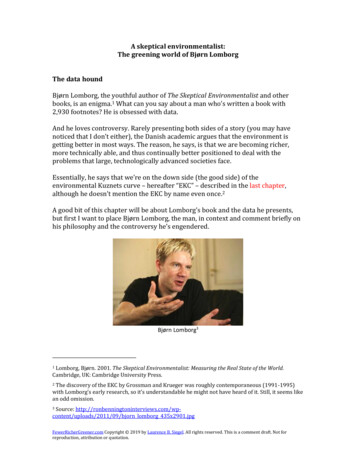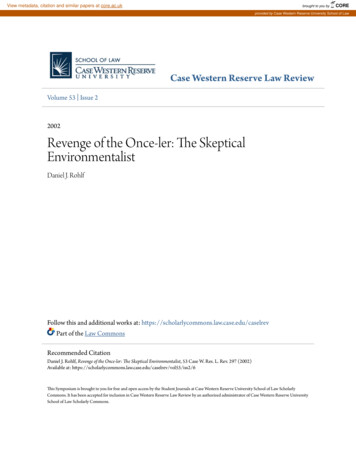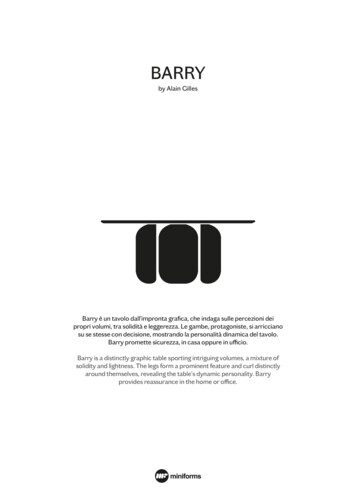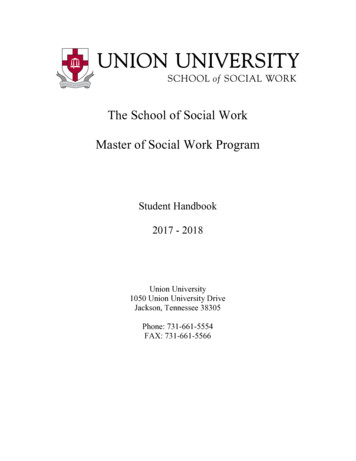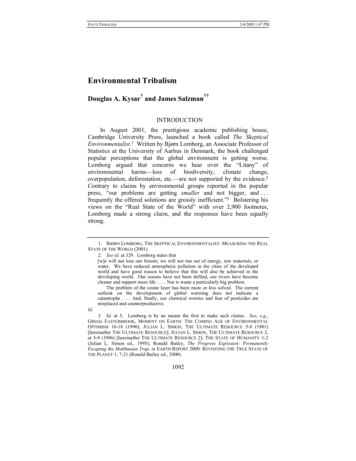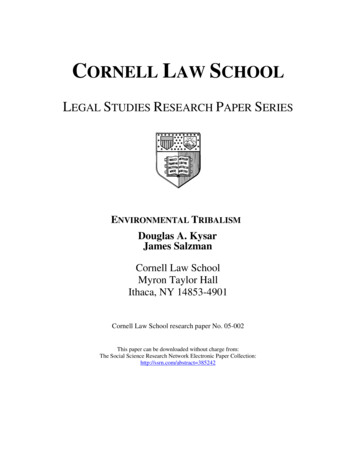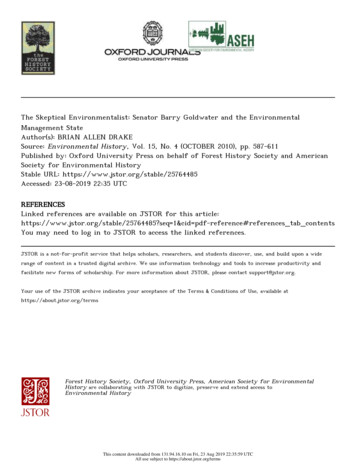
Transcription
The Skeptical Environmentalist: Senator Barry Goldwater and the EnvironmentalManagement StateAuthor(s): BRIAN ALLEN DRAKESource: Environmental History, Vol. 15, No. 4 (OCTOBER 2010), pp. 587-611Published by: Oxford University Press on behalf of Forest History Society and AmericanSociety for Environmental HistoryStable URL: https://www.jstor.org/stable/25764485Accessed: 23-08-2019 22:35 UTCREFERENCESLinked references are available on JSTOR for this article:https://www.jstor.org/stable/25764485?seq 1&cid pdf-reference#references tab contentsYou may need to log in to JSTOR to access the linked references.JSTOR is a not-for-profit service that helps scholars, researchers, and students discover, use, and build upon a widerange of content in a trusted digital archive. We use information technology and tools to increase productivity andfacilitate new forms of scholarship. For more information about JSTOR, please contact support@jstor.org.Your use of the JSTOR archive indicates your acceptance of the Terms & Conditions of Use, available athttps://about.jstor.org/termsForest History Society, Oxford University Press, American Society for EnvironmentalHistory are collaborating with JSTOR to digitize, preserve and extend access toEnvironmental HistoryThis content downloaded from 131.94.16.10 on Fri, 23 Aug 2019 22:35:59 UTCAll use subject to https://about.jstor.org/terms
BRIAN ALLEN DRAKEthe skeptical environmentalist: senator barryGOLDWATERAND THE ENVIRONMENTAL MANAGEMENT STATEABSTRACTFor much of American history, environmental protection and federal power havebeen two peas in a pod. This was especially true after World War II, as economicprosperity created a vast middle class that demanded environmental "beauty,health and permanence" (in Samuel Hays's words) as an indispensable part ofits consumer lifestyle and expected government to secure them. The result wasthe birth, in Adam Rome's phrase, of the "environmental management state" inthe 1960s and early 1970s as environmental protection took its place alongsidenational defense and social welfare as a major federal responsibility. ArizonaSenator Barry Goldwater began his political career in the midst of postwar environmentalism's birth and growth. As a Westerner, a businessman, and a politicalconservative deeply mistrustful of the federal government, Goldwater seems anunlikely candidate for any environmental sympathies, especially of the federalregulatory variety, but a close look at his life reveals a man with a complexrelationship with the natural world, environmentalism, and the environmentalmanagement state. In the end, Goldwater went to his grave without ever fullycoming to terms with the tensions between his environmentalist sympathiesand his conservatism, but nevertheless his environmental odyssey tells us a lotabout the depth and breadth of postwar environmentalism in the United States,as well as the changing conservative movement and the Republican Party.AMERICA WAS A different place in 1970 than it had been only six years before,when the famously conservative Arizona Senator Barry Goldwater ran as the? 2010 The Author. Published by Oxford University Press on behalf of the AmericanSociety for Environmental History and the Forest History Society. All rights reserved.For Permissions, please email: journals.permissions@oxfordjournals.orgBrian Allen Drake, "The Skeptical Environmentalist: Senator Barry Goldwater and theEnvironmental Management State," Environmental History 15 (October 2010): 587-611.doi:10.1093/envhis/emq086Advance Access publication on October 15, 2010This content downloaded from 131.94.16.10 on Fri, 23 Aug 2019 22:35:59 UTCAll use subject to https://about.jstor.org/terms
588 ENVIRONMENTAL HISTORY 15 (OCTOBER 2010)Figure 1. The Senator and the Canyon.Credit: Arizona Historical Foundation, Personal and Political Papers of Barry M. Goldwater, SeriesIV: Photographs.Republican Party's presidential candidate and took an electoral pounding at thehands of Lyndon Johnson. In 1964 most of the era's social and cultural conflagrations were just beginning to blaze-the civil rights movement was in fullswing across the South, but second-wave feminism, the antiwar movement,the New Left, and the counterculture had yet to have their historical moment.Now, at decade's end, steam was rising everywhere as the sixties came to ahead. Among its mushrooming movements was popular environmentalism. Ifthings like air pollution or the loss of green space failed to inspire the levelsof passion seen in the Weathermen or the Black Panthers, they made up forit with breadth of concern, as exemplified by the massive popularity of EarthDay 1970. For the first time, the nation's ecological problems had become thefocus of national grassroots concern, no longer the domain of resource managers, small conservation groups, and local activists alone. Going green hadgone mainstream.1A sign of the times could be found in the penultimate chapter of Goldwater'sthird book, The Conscience of a Majority, published just after his return to theSenate in January 1969. Much of the book was classic Goldwateresque criticismof liberals, labor, and the press, but the chapter "Saving the Earth" wasThis content downloaded from 131.94.16.10 on Fri, 23 Aug 2019 22:35:59 UTCAll use subject to https://about.jstor.org/terms
THE SKEPTICAL ENVIRONMENTALIST 589different. Its gist was simple: environmental problems were real, they wereserious, and now was the time to solve them. It is "our job," warned thesenator, to "prevent that lush orb known as Earth. from turning into ableak and barren, dirty brown planet." But the job was not being done. "Weare in trouble on the Earth in our continuing efforts to survive," he continued,and "it is difficult to visualize what will be left of the Earth if our present ratesof population and pollution expansion are maintained." Indeed, Goldwater said,it was "scarcely possible to claim that man's ability to destroy his environmenthas any serious limitations." No longer was there "any reason to questionwhether the threat is real."2Such sentiments were hardly unusual in those days, as books likeThe Population Bomb, The Closing Circle, and The Limits to Growth testified.They rarely came from conservatives, however, and that fact alone made"Saving the Earth" notable. But the real shocker came when Goldwater musedon possible solutions to the nation's ecological conundrums. Of course, hesaid, he favored local action and market remedies whenever possible. Butthen he admitted that more might be required.I happen to be one, [he wrote] who has spent much of his public lifedefending the business community, the free enterprise system, andlocal governments from harassment and encroachment from an outsizedFederal bureaucracy. [Yet] I feel very definitely that the [Nixon] administration is absolutely correct in cracking down on companies and corporations and municipalities that continue to pollute the nation's air andwater. While I am a great believer in the free competitive enterprisesystem and all that it entails, I am an even stronger believer in theright of our people to live in a clean and pollution-free environment.To this end, it is my belief that when pollution is found, it should behalted at the source, even if this requires stringent government actionagainst important segments of our national economy.Even in the context of the time, it was a rather startling admission."Mr. Conservative," the perennial enemy of outsized federal bureaucracy, wasembracing federal environmental regulation.3Conventional wisdom tends not to associate conservatives with environmentalism, and for good reason, because environmental protection and big government have been closely linked since colonial times. As far back as the early1800s, as John Cumbler, Richard Judd, Brian Donahue, and others have shown,state power was a key weapon for those who would save New England's riparianmeadows and fish runs from the threat of textile-factory milldams. Later thatcentury, Progressive conservationists brandished the power of state-centeredscientific and technical expertise in their crusade for better management ofthe nation's forests, rangelands, and rivers and for the protection of its morescenic parts as well. Indeed, government's role in environmental affairs, bothThis content downloaded from 131.94.16.10 on Fri, 23 Aug 2019 22:35:59 UTCAll use subject to https://about.jstor.org/terms
590 ENVIRONMENTAL HISTORY 15 (OCTOBER 2010)at the state and federal level, grew steadily after the Progressive Era, and by theyears after World War II the "environmental management state" (in AdamRome's words) had joined the welfare state and the military-industrialcomplex as a prominent expression of federal power. With their allergy to government and their tight embrace of industrial capitalism, many postwar conservatives were unsurprisingly hesitant to identify with environmentalism orenvironmentalists; in 1980 the Reagan administration practically declaredwar on them, aiming to roll back federal environmental management a la theSoviets as a part of its larger deregulation campaign.4But not all conservatives were so opposed. Even if he acted mainly out of political expedience, Richard Nixon helped to fashion some of the most importantregulatory tools of the postwar era in the National Environmental ProtectionAct, the Environmental Protection Agency, and the Clean Air Act of 1970, andhis fellow Republican, John Saylor, was a furious opponent of dam buildingin the Grand Canyon in the 1960s and arguably the greatest champion offederal wilderness preservation in the House of Representatives from the1950s through the 1970s. Meanwhile, a close look at the Republican Party, conservatism's partisan home after World War II, shows that it has a very longhistory of support for federal environmental protection, best embodied bymen like Teddy Roosevelt, Gifford Pinchot, and Herbert Hoover. Its modernmembers can thus "claim with considerable justification that [the GOP's]environmental record" before 1980 "was no less distinguished than that ofthe Democrats," says William Cronon.5Such exceptions to the "no green conservatives" rule suggest the accuracy ofSamuel Hays's observation that postwar environmentalism's "values and idealstended not to fit into traditional political ideologies, but to cut across them." ForHays, environmentalism was a creature of consumerism, born out of 1950s economic prosperity and the desire it fostered among large swaths of the public fornatural "amenities" like wilderness, green space, and clean air and water,along with the legislation necessary to preserve them ("beauty, health, and permanence," as he termed it). As such, the environmental movement circa 1970 wasnot a narrow reform effort but a sea change in social values so widespread that itcould sometimes find support even among the most unlikely of champions.6In 1970, and indeed for much of his adult life, Barry Goldwater was one ofthose unlikely champions. Given his intense antistatism, as well as his rootsin the famously libertarian West, we might expect him to have been in uncompromising opposition to federal environmental regulation. But he was also theowner of a legendary independent streak (a "maverick," in current parlance)when it came to issues like abortion and gay rights, and so it was withfederal environmentalism as well. Nature was important to Barry Goldwater,and like so many Americans in the postwar period he was concerned aboutits fate, to the point that he was willing-at times-to invoke federal power forits protection. That willingness was never permanent, though, because whateverGoldwater's hopes about government's ability to save the planet, he remainedThis content downloaded from 131.94.16.10 on Fri, 23 Aug 2019 22:35:59 UTCAll use subject to https://about.jstor.org/terms
THE SKEPTICAL ENVIRONMENTALIST 591an antistatist conservative to the end, and those two sentiments could and didclash. "Green Goldwater" was thus a sporadic phenomenon, closely related tohistorical and personal circumstance. Indeed, the senator was never quiteable to square the tensions between his environmental concerns, his faith incapitalism, and his mistrust of government. Nevertheless, Goldwater'scomplex personal relationship to the natural world tells us a lot about thepower of postwar environmentalism and its influence on both him and thelarger culture.DESERT GENESISGoldwater came to know nature long before he got into politics, and his childhood experiences in particular proved vital to his later environmental sympathies. Although he was a city kid, raised in the middle-class home of awell-to-do Phoenix department store owner, Goldwater grew up surrounded bythe Sonoran Desert, and that raw and dramatic landscape could hardly fail toinfluence a curious, adventurous, and impressionable boy. Young Barry likedto camp and hike on his own around Camelback Mountain (not yet engulfedby Phoenix's urban sprawl), but it was his mother, losephine WilliamsGoldwater, who introduced him more fully to the beauty of Arizona. An independent and irrepressible Midwesterner who first came to Phoenix to find relieffrom tuberculosis, "lo" Goldwater loved to take car-camping trips (an increasingly common activity in the consumer-oriented 1920s) into the desert, at atime when that was no easy feat due to the primitive state of both automotivetechnology and Arizona's rural roads. Leaving husband Baron behind, lo and herthree children regularly rolled and rattled across the Sonoran and camped in theopen, where she would read and lecture to them about Arizona's natural history.Nor did she neglect natural theology. A sincere if not intensely Christianwoman, losephine believed that God's power and glory were manifest inCreation, and that He could be found, in Barry's later words, by "walkingthrough the desert, or walking through the forest, or climbing the mountainsjust as easily as you can [find Him] in a church." Introducing her children toGod's nature was, for Jo, vital to both their moral and intellectual development,and Barry learned his lessons well.7On some of these trips Barry took a camera along, and thus began an avocation he would pursue passionately for the rest of his life: photography, particularly landscape shots and portraits of local Native peoples. He was never aworld-class artist ("Ansel Adam's crown is still safe," legendary WashingtonPost Editor Ben Bradlee teased him in 1984), but nevertheless, Goldwater hadconsiderable talent, enough to earn him a membership in the RoyalPhotographic Society and the praise and friendship of Adams himself.Indeed, one of Goldwater's first brushes with fame was his publication in1940 of a book of his photography entitled Arizona Portraits, which wonacclaim from around the state and garnered the society's membership offer.This content downloaded from 131.94.16.10 on Fri, 23 Aug 2019 22:35:59 UTCAll use subject to https://about.jstor.org/terms
592 ENVIRONMENTAL HISTORY 15 (OCTOBER 2010)Figure 2. Growing Up Wild.Young Barry Goldwater poses, rifle in hand, with his mother Josephine, brother Robert, and sisterCarolyn (along with two others) during one of their many car-camping trips in the Arizona backcountry in the 1920s. Goldwater later traced his political conservatism in part to the influence ofthe state's harsh desert landscape, which, he said, instilled in him a lifelong lesson about theimportance of self-reliance, entrepreneurship, and individualism. Credit: Arizona HistoricalFoundation, Personal and Political Papers of Barry M. Goldwater, Series IV: Photographs.Among impressive shots of Navajos and more prosaic images of cowboys andwagon wheels were a number of landscape scenes, some rather mundane butothers quite striking, suggesting Goldwater's sincere and passionate appreciation for both the physical and spiritual beauty of nature. A second editionwith similar content followed in 1946.8But it was a trip down the Colorado River in 1940 that made Barry Goldwatera household name in Arizona. That summer Goldwater accompanied the Nevillsexpedition through the Grand Canyon, which would be only the thirteenthexpedition to successfully complete the trip since the Powell expedition in1869. While it lacked the dangers and heroics of Powell's legendary run, theNevills expedition nevertheless had its share of adventure in the midst of thecanyon's sublime beauty. Goldwater, who had long dreamed of taking such atrip, found himself moved deeply by the whole experience, as was evident inthe lyricism of some of the passages in the journal he kept: "At this sunsethour the canyon walls are indescribably beautiful. The tall spires near therim . look as though God had reached out and swiped a brush of goldenpaint across them, gilding those rocks in the bright glow of a setting sun.Above this grandeur float soft cumulus clouds, tinted with pastel shades ofevening." Meanwhile, he took hundreds of photographs and some three thousand feet of motion-picture film. Thirty years later, he would publish the bestof the photos, along with the journal, as Delightful Journey Down the Green &Colorado Rivers.9The film actually played a role in setting Goldwater on the road to politicaloffice. There was much public interest in his trip, and by autumn 1940 he wasThis content downloaded from 131.94.16.10 on Fri, 23 Aug 2019 22:35:59 UTCAll use subject to https://about.jstor.org/terms
THE SKEPTICAL ENVIRONMENTALIST 593showing the film to audiences all over Arizona. He estimated that within a yearsome ten thousand people had seen it. He also gave lectures to accompany it,sometimes arriving for showings in more remote locales via his airplane (hewas an avid pilot, as well as a photographer), which lent him an air of tech-sawyindividualism to accompany his new reputation as a rugged outdoorsman. In theprocess Goldwater gained valuable public-speaking experience and, more significantly, made important contacts while polishing his image as a man of action.The film "gave me access to so damn many Arizonans," he noted later, "that itwas just a natural step for me to go into politics." His conservatism mighthave been what attracted many voters to him, but when Goldwater took that"natural step" in 1948 and ran for a seat on the Phoenix city council, he alsohad the canyon as a very attractive and persuasive campaign backdrop.10Figure 3. Arizona Portraits.In the 1930s Goldwater began to roam the Arizona backcountry, taking thousands of photographsof its natural features as well as the people who lived among them. Here, in a photo taken by hiswife Peggy circa 1940, he poses with his movie camera at the edge of Coal Mine Canyon, in thenorth-central part of the state. Credit: Arizona Historical Foundation, Personal and Political Papersof Barry M. Goldwater, Series IV: Photographs.This content downloaded from 131.94.16.10 on Fri, 23 Aug 2019 22:35:59 UTCAll use subject to https://about.jstor.org/terms
594 ENVIRONMENTAL HISTORY 1 5 (OCTOBER 201 0)DAMMING ARIZONAGoldwater's political ascent really began with his election to the Senate in 1952,and, as a Republican from traditionally democratic Arizona, his victory was astraw in the shifting political winds that were turning the Sun Belt into a conservative bastion. He spent much of his first two terms chairing the SenateRepublican re-election committee when he wasn't clashing with labor leadersor railing against communism and the legacy of the New Deal. Environmentalprotection was not much of an issue for him, although he did introduce legislation in 1957 to increase the size of Grand Canyon National Park, a projectthat would later become dear to him. But overall Goldwater was not yet whatmany Americans would recognize as an environmentalist. Quite the opposite,in fact, for he voted against what was perhaps the era's most significantpiece of federal environmental legislation, the Wilderness Act of 1964, anddevoted considerable energy to enlisting the federal government's help indamming the West's rivers, a questionable crusade to many of the nation's wilderness lovers, not to mention a significant qualification to his smallgovernment philosophy.11One of the things that most twentieth-century Western politicians sharedwas an unshakable belief in the virtues of federal reclamation: dams, canals,aqueducts, pumping stations, and so forth, built at public expense for thebenefit of the economy of the western United States. Liberals liked reclamationfor the jobs and cheap energy it provided to the common man and its mission (atleast in theory) to support the idealized small farmer; dam building was a majorcomponent of the New Deal, for example, and had strong Democratic backingafter World War II. Many western Republicans also supported reclamation.Their antistatism made this a rather tricky posture to maintain, but theirdesire for the economic growth to be underwritten by federally subsidizedwater usually trumped their ideology (eastern Republicans such as lohnSaylor tended to be far more resistant to reclamation's charms). Reclamationwas not pork or a government handout, western boosters replied to critics(often with a touch of defensiveness). It was simply a helping hand forhonest, hard-working folks in a severely arid environment, folks who wouldbuild the West up to glorious heights of free enterprise if only they could surmount its environmental obstacles.12For all his complaints about big government, when it came to reclamationGoldwater cheerfully checked his antistatism at the door. Along with hisDemocratic senatorial partner Carl Hayden, Goldwater stumped regularlyfor the Central Arizona Project (CAP), a reclamation scheme to move watersome three hundred miles from Lake Havasu to the area around Phoenixand Tucson, which became one of the most expensive reclamation projectsin the West. "We desperately need [CAP] water for continuing development,"Goldwater declared on the floor of Congress in 1963, with a finality thatsuggested the argument was watertight, as it were. Given his criticisms ofThis content downloaded from 131.94.16.10 on Fri, 23 Aug 2019 22:35:59 UTCAll use subject to https://about.jstor.org/terms
THE SKEPTICAL ENVIRONMENTALIST 595the New Deal-era Tennessee Valley Authority (TVA) as a rogue bureaucracy("conceived in the minds of socialistic planners, born in a period of economicdistress, and nurtured and expanded in deceit") Goldwater's pro-reclamationsentiments hardly endeared him to southern Congressmen and their constituents, who saw the TVA as sacred. They had a point; Goldwater's defense ofreclamation certainly sidestepped the issue of its similarity to TVA projects.Nor were his answers to his critics-that the Constitution implied a federalrole in reclamation while the TVA was unfairly producing and selling electricity, and that reclamation projects always repaid them selves-whollyconvincing.13Goldwater was also an ardent supporter of the biggest federal reclamationplan of the 1950s, the Colorado River Storage Project (CRSP), which aimed tobring the famous river and its tributaries under strict hydrological controlwith a slew of dams and related accoutrements. CRSP boosters argued that itwould deliver to the region the kind of prosperity that heavily irrigatedCalifornia enjoyed; indeed, they said, fairness demanded that Arizona, Utah,New Mexico, and Colorado get a shot at profiting from a watershed whoseuse California essentially monopolized. The heart of the CRSP proposal wasEcho Park Dam, named after its proposed site on the Green River inWyoming. But there was one problem: Echo Park was also inside DinosaurNational Monument. Many in the Sierra Club saw in the plan a replay of theHetch Hetchy controversy some four and a half decades earlier, when the cityof San Francisco built a dam in the eponymous valley inside YosemiteNational Park. Club founder John Muir and his allies fought the dam hard,arguing that not only a place of natural beauty but also the entire "nationalpark principle" was at stake; if a dam could be built inside Yosemite, the veryidea of national parks as places where nature enjoyed protection from suchdevelopment was destroyed. Muir et al. lost in 1914, but the 1950s were yearsof rapidly growing environmental sentiment, and in 1956 the Sierra Club-ofwhich Goldwater was a member-and its allies would triumph (Saylor wouldgive them considerable assistance in Congress). In return for the removal ofEcho Park Dam from the CRSP, they agreed to a replacement in Glen Canyonon the Colorado River itself, upstream from the Grand Canyon.14If dam opponents expected the river-running, desert-loving Goldwater toside with them against the dam, they underestimated his commitment to reclamation. One of his first acts as senator was to cosponsor legislation authorizingthe CRSP, and on the Senate floor he rejected arguments that the Echo ParkDam would harm either the region's beauty or the park principle. On the contrary, he said: by allowing boat traffic on its reservoir, the dam would allow"millions of Americans . to visit this beautiful section of the country eachyear." Enough of Echo Park would still remain after the dam's constructionto satisfy the critics, who ought to be happy, Goldwater concluded, that thecommon man would now be able to experience the beauty that they were sohell-bent on protecting.15This content downloaded from 131.94.16.10 on Fri, 23 Aug 2019 22:35:59 UTCAll use subject to https://about.jstor.org/terms
596 ENVIRONMENTAL HISTORY 15 (OCTOBER 2010)Even the Grand Canyon itself was not off Goldwater's list of potential reclamation sites. In moving water some three hundred miles southeast from LakeHavasu, the CAP would require massive amounts of electrical power forpumping stations, and the proposed Bridge Canyon Dam, to be located justdownstream of Grand Canyon National Park, was to supply it. The resultingreservoir, dozens of miles long and hundreds of feet deep in places, wouldback up several miles into the park itself. As with the Echo Park Dam, wilderness activists in the Sierra Club and elsewhere went ashen at the thoughtand launched a desperate opposition campaign. Once again they were victorious, helping-along with considerable assistance from interstate political rivalries and compromises-to eliminate the dam from the CAP proposal in themid-1960s in exchange for the coal-fired Navajo Generation Plant. ButGoldwater, despite his love for the canyon, felt that reclamation trumped allarguments against the dam. Most of the canyon's beauty would remain, heargued, and what was lost was a fair exchange for the economic growth theproject would stimulate. He was even willing to trade on his reputation as acanyoneer to buttress his arguments. "I have traveled every foot of the riverthrough the Canyon," he told a correspondent, "and I believe that no oneexceeds my own zeal for the Grand Canyon, and I honestly feel that in thiscase, the dam at Bridge would prove advantageous." So intense wasGoldwater's support that years afterward he was still grumbling about theSierra Club's opposition, as if it had been a personal affront.16Finally, even one of the greatest pieces of federal environmental legislationin American history could not win Goldwater's support. For wilderness lovers,the Wilderness Act of 1964 was the fruit of decades' worth of effort to securefederal protection for "untouched" public lands of outstanding aesthetic, spiritual, and ecological character-lands where, in the act's famous words, "theearth and its community of life are untrammeled by man, where man himselfis a visitor who does not remain." While some human activities would beallowed, public lands designated as "wilderness" under the act would be protected from most forms of economic exploitation, like mining, drilling, timbering, and associated road construction. The Wilderness Society and the SierraClub led the charge that secured the legislation (assisted by supporters likeSaylor), which eventually had widespread support in Congress when LyndonJohnson signed it into law in September 1964. Goldwater, however, was oneof only twelve senators to vote against it.17His reasons were varied. Like many in the West, Goldwater fretted aboutfederal wilderness protection "locking up" resources and denying tax revenueto the states, and he also had procedural questions about the act's enforcement.But his main argument was an interesting one. The real problem with the act,Goldwater claimed, was that the protection it offered to "wilderness" wouldtouch off an avalanche of visitors whose combined impact would destroy thevery wilderness qualities that they flocked to see. With increased tourismwould come pressure for more roads, hotels, and restaurants from "dudes" (asThis content downloaded from 131.94.16.10 on Fri, 23 Aug 2019 22:35:59 UTCAll use subject to https://about.jstor.org/terms
THE SKEPTICAL ENVIRONMENTALIST J 597Goldwater termed them) who did not really appreciate wilderness and wereunwilling to hike or pack into it, sleep in a tent, or clean up after themselves.Soon the government would capitulate to their demands and "start puttingsewer lines, gaslines [sic], waterlines, and paved roads" into places like hisbeloved wild Arizona desert. Federal wilderness areas, in other words, woulddie from the law of unintended consequences. Coming from a man who hadrecently argued in favor of dams precisely because they would increasetourism, this argument could seem disingenuous, to say the least. But seenfrom another angle it was a prescient concern, for the spectacular popularityof wilderness areas after World War II would indeed make crowd managementan increasingly thorny issue for wilderness preservationists, a situationRoderick Nash has termed "the irony of victory."18More significantly, this particular criticism of the Wilderness Act revealed agrowing inner ambivalence about the n
The Skeptical Environmentalist: Senator Barry Goldwater and the Environmental Management State Author(s): BRIAN ALLEN DRAKE Source: Environmental History, Vol. 15, No. 4 (OCTOBER 2010), pp. 587-611 Published by: Oxford University Press on behalf of Forest History Society and American Society for Environmental History


